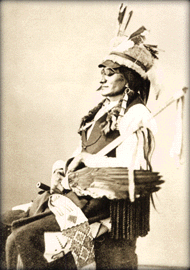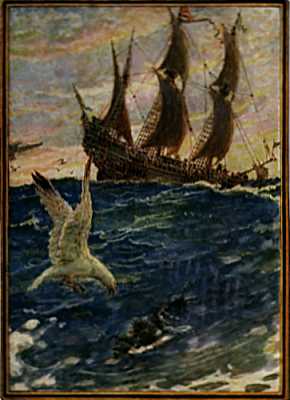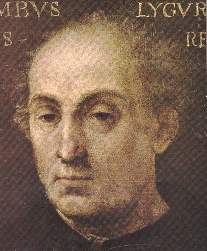Man and Myth
After five centuries, Columbus remains a mysterious and controversial figure who has been variously described as one of the greatest mariners in history, a visionary genius, a mystic, a national hero, a failed administrator, a naive entrepreneur, and a ruthless and greedy imperialist.
Columbus's enterprise to find a westward route to Asia grew out of the practical experience of a long and varied maritime career, as well as out of his considerable reading in geographical and theological literature. He settled for a time in Portugal, where he tried unsuccessfully to enlist support for his project, before moving to Spain. After many difficulties, through a combination of good luck and persuasiveness, he gained the support of the Catholic monarchs, Isabel and Fernando.
The widely published report of his voyage of 1492 made Columbus famous throughout Europe and secured for him the title of Admiral of the Ocean Sea and further royal patronage. Columbus, who never abandoned the belief that he had reached Asia, led three more expeditions to the Caribbean. But intrigue and his own administrative failings brought disappointment and political obscurity to his final years.
When the Taino Indians saved Christopher Columbus from certain death on the fateful morning of October 12, 1492, a glorious opportunity presented itself for the cultures of both Europe and the Americas to flourish.
What occurred was neither glorious nor heroic. Just as Columbus could not, and did not, "discover" a hemisphere already inhabited by nearly 100 million people, his arrival cannot, and will not, be recognized by indigenous peoples as a heroic and festive event.
From a Native perspective, Columbus' arrival was a disaster from the beginning. Although his own diaries reveal that he was greeted by the Tainos with the most generous hospitality he had ever known, he immediately began the enslavement and slaughter of the Indian peoples of the Caribbean.
His life
 The best available evidence suggests that Christopher Columbus (Cristoforo Colombo in Italian; Cristobal Colon in Spanish) was born in Genoa in 1451. His father was a weaver; he had at least two brothers. Christopher had little education and, only as an adult, learned to read and write. He went to sea, as did many Genoese boys, and voyaged in the Mediterranean. In 1476 he was shipwrecked off Portugal, found his way ashore, and went to Lisbon; he apparently traveled to Ireland and England and later claimed to have gone as far as Iceland. He was in Genoa in 1479, returned to Portugal, and married. His wife, Dona Felipa, died soon after his son, Diego, was born (c.1480).
By this time Columbus had become interested in westward voyages. He had learned of the legendary Atlantic voyages and sailors' reports of land to the west of Madeira and the Azores. Acquiring books and maps, he accepted Marco Polo's erroneous location for Japan--2,400 km (1,500 mi) east of China--and Ptolemy's underestimation of the circumference of the Earth and overestimation of the size of the Eurasian landmass. He came to believe that Japan was about 4,800 km (3,000 mi) to the west of Portugal--a distance that could be sailed in existing vessels. His idea was furthered by the suggestions of the Florentine cosmographer Paolo dal Pozzo Toscanelli. In 1484, Columbus sought support for an exploratory voyage from King John II of Portugal, but he was refused. The Portuguese also underestimated the distance but believed it to be beyond the capabilities of existing ships.
In 1485 Columbus took his son Diego and went to Spain, where he spent almost seven years trying to get support from Isabella I of Castile. He was received at court, given a small annuity, and quickly gained both friends and enemies. An apparently final refusal in 1492 made Columbus prepare to go to France, but a final appeal to Isabella proved successful. An agreement between the crown and Columbus set the terms for the expedition.
The best available evidence suggests that Christopher Columbus (Cristoforo Colombo in Italian; Cristobal Colon in Spanish) was born in Genoa in 1451. His father was a weaver; he had at least two brothers. Christopher had little education and, only as an adult, learned to read and write. He went to sea, as did many Genoese boys, and voyaged in the Mediterranean. In 1476 he was shipwrecked off Portugal, found his way ashore, and went to Lisbon; he apparently traveled to Ireland and England and later claimed to have gone as far as Iceland. He was in Genoa in 1479, returned to Portugal, and married. His wife, Dona Felipa, died soon after his son, Diego, was born (c.1480).
By this time Columbus had become interested in westward voyages. He had learned of the legendary Atlantic voyages and sailors' reports of land to the west of Madeira and the Azores. Acquiring books and maps, he accepted Marco Polo's erroneous location for Japan--2,400 km (1,500 mi) east of China--and Ptolemy's underestimation of the circumference of the Earth and overestimation of the size of the Eurasian landmass. He came to believe that Japan was about 4,800 km (3,000 mi) to the west of Portugal--a distance that could be sailed in existing vessels. His idea was furthered by the suggestions of the Florentine cosmographer Paolo dal Pozzo Toscanelli. In 1484, Columbus sought support for an exploratory voyage from King John II of Portugal, but he was refused. The Portuguese also underestimated the distance but believed it to be beyond the capabilities of existing ships.
In 1485 Columbus took his son Diego and went to Spain, where he spent almost seven years trying to get support from Isabella I of Castile. He was received at court, given a small annuity, and quickly gained both friends and enemies. An apparently final refusal in 1492 made Columbus prepare to go to France, but a final appeal to Isabella proved successful. An agreement between the crown and Columbus set the terms for the expedition.
The First Voyage
The Pinta, the Nina, and the Santa Maria were outfitted in the minor port of Palos. Columbus was aided in recruiting a crew by two brothers--Martin Alonzo Pinzon, who received command of the Pinta, and his younger brother Vicente Yanez Pinzon, who commanded the Nina. They left Palos on Aug. 3, 1492, rerigged the Nina in the Canaries, and sailed to the west. A landfall was made on the morning of Oct. 12, 1492, at an island in the Bahamas, which Columbus named San Salvador.
 The landing was met by Arawak, a friendly local population that Columbus called Indians. Some days later the expedition sailed on to Cuba, where delegations were landed to seek the court of the Mongol emperor of China and gold. In December they sailed east to Hispaniola, where, at Christmas, the Santa Maria was wrecked near Cap-Haitien. Columbus got his men ashore. The Indians seemed friendly; so 39 men were left on the island at the settlement of Navidad while Columbus returned to Spain on the Nina. He had sailed due west from the Canaries with favorable winds; now he sailed north before heading east and so again found favorable winds. Martin Alonzo Pinzon, who had explored on his own with the Pinta, rejoined Columbus, but the ships were separated at sea. Columbus finally landed (March 1493) in Lisbon and was interviewed by John II. Then he went to Palos and across Spain to Barcelona, where he was welcomed by Isabella and her husband, Ferdinand II of Aragon. Columbus claimed to have reached islands just off the coast of Asia and brought with him artifacts, Indians, and some gold.
The landing was met by Arawak, a friendly local population that Columbus called Indians. Some days later the expedition sailed on to Cuba, where delegations were landed to seek the court of the Mongol emperor of China and gold. In December they sailed east to Hispaniola, where, at Christmas, the Santa Maria was wrecked near Cap-Haitien. Columbus got his men ashore. The Indians seemed friendly; so 39 men were left on the island at the settlement of Navidad while Columbus returned to Spain on the Nina. He had sailed due west from the Canaries with favorable winds; now he sailed north before heading east and so again found favorable winds. Martin Alonzo Pinzon, who had explored on his own with the Pinta, rejoined Columbus, but the ships were separated at sea. Columbus finally landed (March 1493) in Lisbon and was interviewed by John II. Then he went to Palos and across Spain to Barcelona, where he was welcomed by Isabella and her husband, Ferdinand II of Aragon. Columbus claimed to have reached islands just off the coast of Asia and brought with him artifacts, Indians, and some gold.
...
Columbus and Dead Reckoning (DR) navigation
At the end of the fifteenth century, celestial navigation was just being developed in Europe, primarily by the Portuguese. Prior to the development of celestial navigation, sailors navigated by "deduced" (or "dead") reckoning, hereafter called DR. This was the method used by Columbus and most other sailors of his era. In DR, the navigator finds his position by measuring the course and distance he has sailed from some known point. Starting from a known point, such as a port, the navigator measures out his course and distance from that point on a chart, pricking the chart with a pin to mark the new position. Each day's ending position would be the starting point for the next day's course-and-distance measurement.
In order for this method to work, the navigator needs a way to measure his course, and a way to measure the distance sailed. Course was measured by a magnetic compass, which had been known in Europe since at least 1183. Distance was determined by a time and speed calculation: the navigator multiplied the speed of the vessel (in miles per hour) by the time traveled to get the distance.
In Columbus's day, the ship's speed was measured by throwing a piece of flotsam over the side of the ship. There were two marks on the ship's rail a measured distance apart. When the flotsam passed the forward mark, the pilot would start a quick chant, and when it passed the aft mark, the pilot would stop chanting. (The exact words to such a chant are part of a lost oral tradition of medieval navigation). The pilot would note the last syllable reached in the chant, and he had a mnemonic that would convert that syllable into a speed in miles per hour. This method would not work when the ship was moving very slowly, since the chant would run to the end before the flotsam had reached the aft mark.
Speed (and distance) was measured every hour. The officer of the watch would keep track of the speed and course sailed every hour by using a toleta, or traverse board. This was a peg-board with holes radiating from the center along every point of the compass. The peg was moved from the center along the course traveled, for the distance made during that hour. After four hours, another peg was used to represent the distance made good in leagues during the whole watch. At the end of the day, the total distance and course for the day was transferred to the chart.
Columbus was the first sailor (that we know of) who kept a detailed log of his voyages, but only the log of the first voyage survives in any detail. It is by these records that we know how Columbus navigated, and how we know that he was primarily a DR navigator.
Since DR is dependent upon continuous measurements of course and distance sailed, we should expect that any log kept by a DR navigator would have these records; and this is exactly what Columbus's log looks like. If Columbus had been a celestial navigator, we would expect to see continuous records of celestial observations; but Columbus's log does not show such records during either of the transatlantic portions of the first voyage.
It has been supposed by some scholars that Columbus was a celestial navigator anyway, and kept his celestial records hidden for some unknown reason. (This supposition is necessary to support some theories of the first landfall.) But this hypothesis does not hold water. Columbus's ships were steered by helmsmen at a tiller, below the quarterdeck. The helmsmen could not see the sky, so the only way they could keep a course was by magnetic compass. The officer of the deck had his own compass, and would call down course changes as necessary. This means that the courses used aboard ship (and in the log) would have been magnetic courses.
Now suppose that Columbus was using unrecorded celestial checks on his latitude as he sailed west on his first voyage. In that case, as magnetic variation pulled his course southward from true west, he would have noticed the discrepancy from his celestial observations, and he would have corrected it. In other words, if Columbus were a celestial navigator, we would expect to see a series of small intermittent course corrections in order to stay at a celestially determined latitude. These corrections should occur about every three or four days, perhaps more often.
But that is not what the log shows. On the first voyage westbound, Columbus sticks doggedly to his (magnetic) westward course for weeks at a time. Only three times does Columbus depart from this course: once because of contrary winds, and twice to chase false signs of land southwest. In none of these cases does he show any desire to return to a celestially-determined latitude.
|






 View movies about the Middle Ages
View movies about the Middle Ages 
